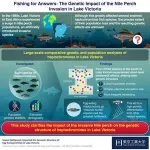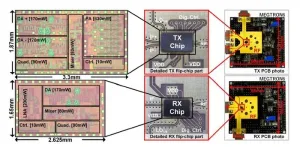(Press-News.org) Newfound evidence reveals that the upsurge of the exotic Nile perch in Lake Victoria had long-lasting effects on the genetic diversity of various local cichlid species, report scientists from Tokyo Tech. Through large-scale comparative genomic analyses, the researchers found concrete proof in the collective genome of multiple species that this artificially introduced perch decimated many local fish populations, causing a 'bottleneck effect.'
The careless introduction of exotic species by humans into ecosystems can lead to truly catastrophic results, as has been proven time and time again. One tragic example is the introduction of the Nile perch, a large freshwater fish found in waterbodies in Africa, into Africa’s largest lake—Lake Victoria.
Brought to Lake Victoria in the 1950s to meet commercial demand for its meat, the Nile perch devastated native populations of fish known as haplochromine cichlids. By the 1990s, experts estimated that more than 200 species of endemic cichlids had been driven to extinction by this fierce predator. Interestingly, the remaining species could also have been deeply affected by the severe population loss caused by the Nile perch, since such events tend to reduce the genetic diversity of surviving groups. However, how much the genetic structure of cichlids was affected by the introduction of the Nile perch remains unclear.
Against this backdrop, a research team from Tokyo Institute of Technology (Tokyo Tech), The Graduate University for Advanced Studies, SOKENDAI in Japan and Tanzania Fisheries Research Institute in Tanzania decided to shed some light on the issue. In their latest study, which was published in Molecular Biology and Evolution, the researchers conducted large-scale comparative genomics analyses on multiple species of cichlids endemic to Lake Victoria, which provided detailed insights into the effects of the invasive Nile perch since its introduction to this environment. The team included Associate Professor Masato Nikaido and doctoral student Minami Imamoto from Tokyo Tech.
Through a genomic analysis that included 137 haplochromine species, the researchers discovered that four species from the Mwanza Gulf (located in the southern part of the lake) experienced what is known as a ‘bottleneck event.’ In simple terms, the population of these species was reduced so much that the genetic diversity within the population had significantly decreased.
Further investigation by the researchers painted the Nile perch as the culprit for the observed changes in the genetic structure of these four species. “The timing of the bottleneck, which began during the 1970s–1980s and ended by the 1990s-2000s, corresponded to the historical records of these endemic haplochromines’ disappearance and later resurgence,” explains Nikaido. “This is likely associated with the introduction of Nile perch by commercial demand to Lake Victoria in the 1950s” he further adds.
Out of the four species, the researchers noted that the egg-eating cichlids Haplochromis sp. ‘matumbi hunter’ and Haplochromis microdon had experienced particularly severe bottleneck effects. For matumbi hunter, this effect was so pronounced that its genome had diverged significantly even from those of closely related species. “Our findings support the previously existing hypothesis that carnivorous fishes, including egg-eaters, should have experienced a stronger bottleneck,” remarks Nikaido, “This study presents, for the first time, the impacts of the Nile perch upsurge on the genetic structure of Lake Victoria haplochromines” he further adds.
Worth noting, the loss of genetic diversity due to short-term bottleneck effects can seriously hamper a species’ fitness and adaptability in the long-term. Thus, taken together, these newfound insights tell a cautionary tale of just how bad the introduction of exotic species can be, even for species that survive extinction.
Researchers identified species that suffered severe damage due to the introduction of Nile perch, providing new insights into conservational biology. Genetic evaluations can offer practical solutions for protecting local fauna, such as discovering species needing urgent protection and establishing no-fishing zones. Notably, some cichlid species, previously thought extinct, are gradually being rediscovered. Furthermore, developing conservational strategies based on comparative genomics may facilitate the resurgence of the ecosystem.
###
About Tokyo Institute of Technology
Tokyo Tech stands at the forefront of research and higher education as the leading university for science and technology in Japan. Tokyo Tech researchers excel in fields ranging from materials science to biology, computer science, and physics. Founded in 1881, Tokyo Tech hosts over 10,000 undergraduate and graduate students per year, who develop into scientific leaders and some of the most sought-after engineers in industry. Embodying the Japanese philosophy of “monotsukuri,” meaning “technical ingenuity and innovation,” the Tokyo Tech community strives to contribute to society through high-impact research.
https://www.titech.ac.jp/english/
END
With wildfires becoming more frequent and extensive in Canada, it’s important for people to understand the health risks of wildfire smoke. An article in CMAJ (Canadian Medical Association Journal) https://www.cmaj.ca/lookup/doi/10.1503/cmaj.240135 aims to provide information for clinicians and people in Canada as wildfire season is upon us.
"As climate change causes more frequent and severe wildfires, wildfire smoke becomes a larger health problem,” says Dr. Mehdi Aloosh, assistant professor, Health Research Methods, Evidence, and Impact, McMaster University, Hamilton, and medical officer of health of Windsor–Essex County, Ontario. “Communities need ...
Children across the United States who identify as LGBTQ+ say the sexual health education curricula they receive is leaving them without essential information to make informed decisions about their sexual health – which could force them to seek potentially dangerous advice elsewhere.
The results of a new, national, peer-reviewed survey, show that these young people — aged 13 to 17 — believe crucial topics surrounding sexual orientation and gender identity are being omitted from sexual health education programs.
Experts who led the study – published today in The Journal of Sex Research, as people around the ...
WASHINGTON – A rigorous, comprehensive synthesis of evidence from 62 studies related to the use of oral nicotine pouches by Georgetown University’s Lombardi Comprehensive Cancer Center scientists and colleagues provides a much-needed assessment of how these products could lead to potential harmful consequences if used by young people.
Oral nicotine pouches were first introduced in the U.S. in the past decade and are pre-portioned white granular packets containing nicotine placed between the gums and lips, marketed as tobacco-free, and are sold in various flavors and nicotine strengths.
The findings appeared ...
A recently developed wirelessly powered 5G relay could accelerate the development of smart factories, report scientists from Tokyo Tech. By adopting a lower operating frequency for wireless power transfer, the proposed relay design solves many of the current limitations, including range and efficiency. In turn, this allows for a more versatile and widespread arrangement of sensors and transceivers in industrial settings.
One of the hallmarks of the Information Age is the transformation of industries towards a greater flow of ...
A new D-band CMOS transceiver chipset with 56 GHz signal-chain bandwidth achieves the highest transmission speed of 640 Gbps for a wireless device realized with integrated circuits, as reported by researchers from Tokyo Tech and National Institute of Information and Communications Technology. The proposed chipset is highly promising for the next generation of wireless systems.
To achieve faster speeds and handle increasing data traffic, wireless systems are operating in higher millimeter-wave frequency bands. Current high-band 5G systems offer speeds as high as 10 Gbps and operate in frequency bands between 24–47 GHz. The next generation ...
Peer-reviewed – Qualitative study - Humans
A new study has provided an in-depth look into the rising trend of disposable vape use among young people in the UK.
The research, led by the University of East Anglia, reveals that young people see smoking and vaping as interchangeable, but are far more aware of the potential harms of vaping than they are of the dangers of smoking.
The findings also suggest that banning disposable vape products or increasing their prices could lead young people to revert to smoking tobacco.
Many of the young people questioned also believed that ...
Atlanta, Ga.—Eczema, a skin inflammatory disease that causes dry, itchy and inflamed skin, affects millions worldwide. Eczema is associated with an altered skin microbiome and higher colonization by Staphylococcus aureus. The study, led at New York Medical by postdoctoral fellow Anish R. Maskey, Ph.D., focuses on the natural compound berberine and its impact on eczema exacerbated by S. aureus. The findings, presented at ASM Microbe, shed light on berberine’s ability to inhibit S. aureus colonization and alleviate eczema symptoms without adverse effects.
Current ...
A data-driven intervention that engaged communities to rapidly deploy evidence-based practices to reduce opioid-related overdose deaths – such as increasing naloxone distribution and enhancing access to medication for opioid use disorder – did not result in a statistically significant reduction in opioid-related overdose death rates during the evaluation period, according to results from the National Institutes of Health’s HEALing (Helping to End Addiction Long-Term) Communities Study. Researchers identified the COVID-19 pandemic and increased prevalence ...
Atlanta, GA – New research has shed light on the effects of protein-rich diets on the gut microbiome and overall health. Despite the increasing protein intake in Western diets, especially among athletes and individuals with obesity, the fate of undigested protein and its impact on human health remains largely unknown. A new study, presented at ASM Microbe, explores how excess undigested protein in the colon can be fermented to produce beneficial metabolites, such as short-chain fatty acids (SCFAs), or lead to the production of harmful metabolites like ammonia and sulfides, which are linked to gastrointestinal disorders and other health issues.
The research team conducted a series of experiments ...
Highlights:
Mouse studies suggest a link between the gut microbiome and neurodegenerative diseases, but the pathways remain unclear.
New study reports distinct bacterial and metabolite profile in patients with Alzheimer’s disease and other neurodegenerative diseases.
The study flagged the metabolite DHPS as a possible missing link in our understanding of how gut microbes influence NDDs through sulfur metabolism pathways.
Atlanta, Ga.—Neurodegenerative diseases (NDDs), which have no known cures and elusive causes, result in irreversible damage to the brain and nervous system. Research into these diseases typically focuses on the brain, but mouse ...



